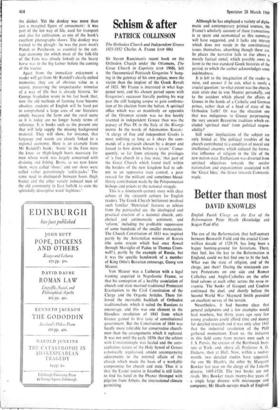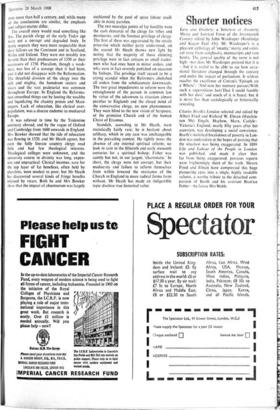Better than most
DAVID KNOWLES The eve of the Reformation, that half-century between Bosworth Field and the crucial Crom- wellian decade of 1529-39, has long been a happy hunting-ground for historians. There, they feel, lies the key to the Reformation in England, could we but find one to fit the lock. What was the state of religion, and of the clergy, just then? During the nineteenth cen- tury Protestants on one side and Roman Catholics and Anglo-Catholics on the other fired salvoes at each other across the terra in- cognita. The books of Gasquet and Coulton continued the duel, and shortly before the Second World War Maynard Smith provided an excellent survey of the terrain.
Nevertheless, it had become clear that general judgments and a few examples would lead nowhere, but thirty years ago very few young graduates could afford time and money for detailed research and it was only after 1945 that the industrial revolution of the PhD gathered momentum. Even so, the initiative in this field came from mature men such as J. S. Purvis, the creator of the Borthwick Insti- tute at York, and, above all, Professor A. G. Dickens, then at Hull. Now, within a twelve- month, two detailed studies have appeared, the one Mr Heath's, the other by Margaret Bowker last year on the clergy of the Lincoln diocese, 1495-1520. The two books are not rivals. Mrs Bowker treats twenty-five years of a single large diocese with microscope and computer; Mr Heath surveys much of England
over more than half a century, and, while many of the conclusions are similar, the emphasis and subject-matter differ.
The overall story would read something like this. The parish clergy of the early Tudor age were not a corrupt and degraded body. In many respects they were more respectable than their fellows on the Continent and in Scotland, Wales and Ireland. They were not notably less fervent than their predecessors of 1350 or their successors of 1750. Pluralism, though a weak- ness, was less of a scourge than it had been, and it did not disappear with the Reformation. The threefold division of the clergy into the rich and mighty, the humdrum - rectors and vicars and the vast proletariat was common throughout Europe. In England the Reforma- tion smoothed things out by looting the wealthy and liquidating the chantry priests and Mass- singers. Lack of education, like clerical over- population, was a disease endemic to mediaeval Europe.
It was relieved in time by the Tridentine seminary abroad, and by the vogue of Oxford and Cambridge from 1600 onwards in England. Mrs Bowker showed that the tide of education was flowing in 1520, and Mr Heath agrees, but even the fully literate country clergy read little and had few theological interests. Theological colleges were unknown, and the university course in divinity was long, expen- sive and unpractical. Clerical incomes, save for the top layer of fat benefices, often held by pluralists, were modest to poor, but Mr Heath has discovered several kinds of fringe benefits enjoyed by vicars. Both he and Mrs Bowker show that the impact of absenteeism was largely cushioned by the pool of spare labour avail- able in many parishes.
The two neuralgic points of lay hostility were the cash demands of the clergy for tithes and mortuaries, and the forensic privilege of clergy. The first of these was aggravated by the steady price-rise which neither party understood; on the second Mr Heath throws new light by noting that the majority of those claiming privilege were in fact artisans or small trades- men who had once been in minor orders, and who were in fact severely punished on occasion by bishops. The privilege itself ceased to be a crying scandal when the Reformers abolished all orders from the subdiaconate downwards. The two great impediments to reform were the entanglement of the parson in common law by virtue of the advowson (a situation almost peculiar to. England) and the closed mind of the conservative clergy, no new phenomenon. They were blind to the new vision of Scripture, of the primitive Church and of the human Christ of Erasmus.
Scandals, according to Mr Heath, were statistically fairly rare; he is hesitant about celibacy, which in any case was unchangeable in the prevailing context. He rightly notes the absence of any internal spiritual reform; we look in vain in the fifteenth.and early sixteenth centuries for a spiritual bishop; Fisher was saintly but not, in our jargon, 'charismatic.' In short, the clergy were not corrupt, but their mediocrity and failure to reform themselves from within lowered the resistance of the Church in England to more radical forms from without. Mr Heath has made an indigestible topic disclose true historical value.



































 Previous page
Previous page